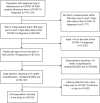Glycemic Control and Clinical Outcomes in U.S. Patients With COVID-19: Data From the National COVID Cohort Collaborative (N3C) Database
- PMID: 35202458
- PMCID: PMC9174972
- DOI: 10.2337/dc21-2186
Glycemic Control and Clinical Outcomes in U.S. Patients With COVID-19: Data From the National COVID Cohort Collaborative (N3C) Database
Abstract
Objective: The purpose of the study is to evaluate the relationship between HbA1c and severity of coronavirus disease 2019 (COVID-19) outcomes in patients with type 2 diabetes (T2D) with acute COVID-19 infection.
Research design and methods: We conducted a retrospective study using observational data from the National COVID Cohort Collaborative (N3C), a longitudinal, multicenter U.S. cohort of patients with COVID-19 infection. Patients were ≥18 years old with T2D and confirmed COVID-19 infection by laboratory testing or diagnosis code. The primary outcome was 30-day mortality following the date of COVID-19 diagnosis. Secondary outcomes included need for invasive ventilation or extracorporeal membrane oxygenation (ECMO), hospitalization within 7 days before or 30 days after COVID-19 diagnosis, and length of stay (LOS) for patients who were hospitalized.
Results: The study included 39,616 patients (50.9% female, 55.4% White, 26.4% Black or African American, and 16.1% Hispanic or Latino, with mean ± SD age 62.1 ± 13.9 years and mean ± SD HbA1c 7.6% ± 2.0). There was an increasing risk of hospitalization with incrementally higher HbA1c levels, but risk of death plateaued at HbA1c >8%, and risk of invasive ventilation or ECMO plateaued >9%. There was no significant difference in LOS across HbA1c levels.
Conclusions: In a large, multicenter cohort of patients in the U.S. with T2D and COVID-19 infection, risk of hospitalization increased with incrementally higher HbA1c levels. Risk of death and invasive ventilation also increased but plateaued at different levels of glycemic control.
© 2022 by the American Diabetes Association.
Figures



References
-
- COVID-19 Map-Johns Hopkins Coronavirus Resource Center . Accessed 27 August 20201, Available from https://coronavirus.jhu.edu/map.html
-
- Hartmann-Boyce J, Morris E, Goyder C, et al. Diabetes and COVID-19: risks, management, and learnings from other national disasters. Diabetes Care 2020;43:1695–1703 - PubMed
Grants and funding
- UL1 TR003096/TR/NCATS NIH HHS/United States
- UL1 TR002649/TR/NCATS NIH HHS/United States
- UL1 TR002537/TR/NCATS NIH HHS/United States
- UL1 TR002535/TR/NCATS NIH HHS/United States
- UL1 TR001422/TR/NCATS NIH HHS/United States
- U54 GM104942/GM/NIGMS NIH HHS/United States
- UL1 TR001420/TR/NCATS NIH HHS/United States
- UL1 TR002240/TR/NCATS NIH HHS/United States
- UL1 TR001439/TR/NCATS NIH HHS/United States
- U54 GM104938/GM/NIGMS NIH HHS/United States
- K23 DK124654/DK/NIDDK NIH HHS/United States
- UL1 TR002494/TR/NCATS NIH HHS/United States
- UL1 TR002736/TR/NCATS NIH HHS/United States
- U54 GM115516/GM/NIGMS NIH HHS/United States
- UL1 TR002369/TR/NCATS NIH HHS/United States
- UL1 TR002538/TR/NCATS NIH HHS/United States
- U54 GM115458/GM/NIGMS NIH HHS/United States
- UL1 TR001453/TR/NCATS NIH HHS/United States
- UL1 TR002489/TR/NCATS NIH HHS/United States
- U54 GM104940/GM/NIGMS NIH HHS/United States
- UL1 TR003107/TR/NCATS NIH HHS/United States
- INV-018455/GATES/Gates Foundation/United States
- UL1 TR003015/TR/NCATS NIH HHS/United States
- UL1 TR002733/TR/NCATS NIH HHS/United States
- U24 TR002306/TR/NCATS NIH HHS/United States
- UL1 TR001876/TR/NCATS NIH HHS/United States
- UL1 TR002003/TR/NCATS NIH HHS/United States
- U54 GM104941/GM/NIGMS NIH HHS/United States
- UL1 TR002553/TR/NCATS NIH HHS/United States
- UL1 TR002389/TR/NCATS NIH HHS/United States
- UL1 TR002014/TR/NCATS NIH HHS/United States
- UL1 TR002319/TR/NCATS NIH HHS/United States
- UL1 TR001855/TR/NCATS NIH HHS/United States
- UL1 TR001425/TR/NCATS NIH HHS/United States
- UL1 TR002373/TR/NCATS NIH HHS/United States
- UL1 TR001873/TR/NCATS NIH HHS/United States
- P30 DK124723/DK/NIDDK NIH HHS/United States
- UL1 TR001450/TR/NCATS NIH HHS/United States
- U54 GM115428/GM/NIGMS NIH HHS/United States
- UL1 TR002345/TR/NCATS NIH HHS/United States
- UL1 TR002544/TR/NCATS NIH HHS/United States
- UL1 TR003098/TR/NCATS NIH HHS/United States

